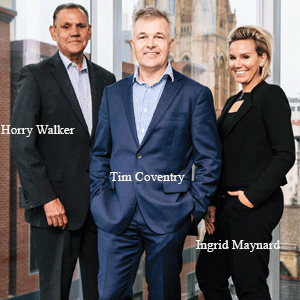THANK YOU FOR SUBSCRIBING

Help Drive the Beginning of a Digital Journey
Damian Fasciani, Technology Director, Caydon Property


Damian Fasciani, Technology Director, Caydon Property
What motivates us to get out of bed in the morning and go to work? Everyone is motivated by different things, for me it is about creating purpose, vision, and using technology to enable a business strategy. There isn’t a better opportunity than a green field’s one, the chance to create something from the ground up. At Caydon, the opportunity arose for me to build a technology function to help drive the beginning of a digital journey.
Getting Started
Before building anything, time is spent listening and learning. Understanding the operating model, how the industry works and speaking to those around me to really get a fundamental grasp on the ‘current state.’ You could call this the Gemba Walk, you can execute the gemba in many ways, but essentially it is a mechanism to understand what is happening on the ground in an operational sense. Someone once told me that you have two ears and one mouth, so you should listen twice as much as you speak. While gembering and understanding your new enviroment, I ask questions and perform certain tasks to ensure I have the information I need to start thinking about what the building blocks for a technology team should look like. I’m a technologist at heart but having come from an agile background (and a hobby in art and design), I keep an A4 book with me at all times. While speaking with my new work colleagues, attend meetings and workshops I get visual. Everything from writing notes, to sketching workflows and brainstorming ideas. If you read through my book, you should notice a trend in my learning, ideas, and priorities.
Establishing a Technology Strategy
As I understand the business and become familiar with my surroundings, I start to iteratively work on a purpose over time. A technology purpose is best formulated once you understand the broader business strategy. Once I have the purpose established, I think about how that purpose is linked to:
• A forming technology strategy
• An operational roadmap
• Variations of a technology team and roles
• Team operating model
• Methods of execution
The team purpose and strategy start in my book through a series of mind maps, notes from meetings with my stakeholders, and understanding the business direction. Once I have a draft of both, I think about how the strategy is broken down in a lean way. I learned early on in my career that defining a strategy in the form of a document doesn’t always hit the mark. Most people won’t make the time to read a ten-page strategy. In a lean way, I establish five pillars/streams that make up the technology strategy, each one created to enable the business while at the same time defining the role technology will play broadly across the organisation.
Once I have the five streams established, I go to my book to define a definition of each with an example. On paper at this point I have the following:
• A defined purpose and mission statement for technology
• Five pillars/streams each with a clear definition and example that form our strategic direction
Lean Execution
Once the above is documented and sketched out in my book, I run them by a senior representative of the business to gain feedback. Using that feedback, I go back and think about how my team will execute on the strategy and deliver on the broader business outcome.
With a Trello board and some of the work carded up already, I go through the board with the team to understand the nature of the work that is there, and also establish what is in progress that is not carded up. Once this is done, the following walls are established.
In Order For The Team To Understand How They Are Contributing To The Broader Technology Strategy, We Have Created Labels That Are Colour Coded On All Our Walls That Link Directly Back To Our Five Strategic Pillars
- A BAU Wall: This wall is created to visualise our adhoc work, anything that is under five days’ work should be placed on this board. While we don’t card up every single task, we talk about anything that adds business value should be carded up.
- A Project Wall: As a starting point, any initiative that is estimated to be more than five days’ work is classified as project. The project wall already has cards that represent broader initiatives for the business.
- A Digital Wall: This wall represented work we are doing with an external partner on our three new consumer digital products. The work here is important enough to constitute its own board and direct focus.
- A CRM Wall: Our CRM is an important part and core to our business holding our customer data. We have established a wall with initiatives directly related to that platform.
While you may think the there is a lot there, the switch between each wall is done as needed and at any time we can visualise and see who is working on what task.
The Link between Operations and Strategy
In order for the team to understand how they are contributing to the broader technology strategy, we have created labels that are colour coded on all our walls that link directly back to our five strategic pillars”
Those labels represent the five strategic pillars/streams that define our strategy. As you look through the walls, you can quickly see the following:
- How much work is BAU related vs. Project vs. Consumer Products vs. the CRM
- The type of work within each wall, and who is working on it.
Each wall was designed with a simple structure; this structure was created to promote adoption of an agile way of working in the team, and to be able to quickly establish our operating rhythm. The faster we can establish the two, the more value we will add in the business.
- Discovery: Any idea or concept that we think may add value in the future is carded up in this lane
- Backlog: Once we know that an idea that is no longer in discovery and will be undertaken in the future gets placed in our backlog
- In Progress: Work that is in flight, being worked on by people in the team or cross-functionally with other teams moves into this lane.
- Blocked: if we can’t continue on a task / piece of work because we are waiting on a partner or someone in the business who is critical to the delivery, we place the card here.
- Testing: Any technical work that requires testing of any kind is captured here.
- Done: HORAY! We have completed what we set out all the way back in discovery.
Initially, the boards are revived formally twice a week at a 15 minute stand up. The team is encouraged to work from the board daily though and to keep it up to date.
Looking to the future
With a defined purpose, strategy,pillars/streams, and a simple, agile operating model in place, you look to the future. Trying to look around the bend and proactively set out to deliver value. In an iterative way. To do this, you establish a roadmap. It’s not easy to do, after conversations with teams in the business about how they operate and what they want from technology(including our new digital consumer products) the roadmap is drafted over a period of time.
The roadmap is split across two overarching areas of technology. The Digital Consumer Experience - which are our new three digital products, and Workplace Technology – enabling our employees to get the most out of technology.
The roadmap goes through several iterations and is planned out for a two-year horizon. Nothing is set in stone that far out, my philosophyon roadmaps is that they should evolve with a degree of flexibility. Flexible in the sense that your business changes, priorities change, and if technology can’t flex with that, then you will find yourself in an awkward position. No matter what, you should be seen as an enabler in your organisation, a proactive enabler. My method for doing this, is to review the roadmap once a quarter. If needed, it is reviewed sooner. Only if needed, you need continuity in what you’re working on at the same time.
Try, if you Fail. Change.
With all being said and done, the foundation is laid for a greenfields technology team to deliver value to its business in an agile and lean manner. You can mix structure, process and a lean mindset into a team. Encourage your people to speak up and provide feedback if certain parts of your operating rhythm are not working. If something sounds like it can work, try it; if it works keep going with it, but if it doesn’t you must act quickly. Iterate, and evolve. As a leader, always remember that you’re not the only one that comes up with ideas. Use the people around you, delegate at the right time and promote autonomy (this needs to be earned). This, in turn, will create a culture of people development, accountability, and responsibility. Once the operating rhythm is in full flight, watch the boards evolve and your people will own it.
Weekly Brief
I agree We use cookies on this website to enhance your user experience. By clicking any link on this page you are giving your consent for us to set cookies. More info
Read Also
Navigating Compliance Challenges in ESG AML and Digital Onboarding
A Vision for the Future: Automation, Robotics, and the Smart Factory
The Rise of Hyper Automation
Transforming Business Operations with Robotic Process Automation
Combining Automation with AI to Achieve Human-Like Interaction
Implementing RPA - 5 Ultimate Prerequisite
Incorporating the power of recognition into our vendors' sustainability journey
Elevating Guest Experience with Data




















